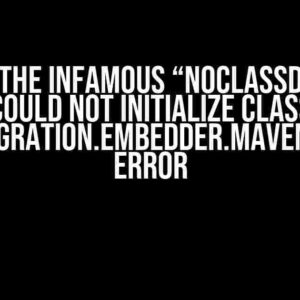Are you tired of encountering the ForegroundServiceStartNotAllowedException when using WorkManager in your Android app? This frustrating error can bring your app to a grinding halt, leaving you scratching your head and wondering what went wrong. Fear not, dear developer, for we’re about to dive into the world of ForegroundServiceStartNotAllowedException and guide you through the process of resolving this pesky issue once and for all!
What is ForegroundServiceStartNotAllowedException?
The ForegroundServiceStartNotAllowedException is an exception thrown by the WorkManager when your app attempts to start a foreground service that is not allowed to run in the foreground. This typically occurs when you’re trying to start a foreground service from the background, which is a no-no in Android Oreo (API 26) and later versions.
Why does this happen?
The Android system has strict restrictions on starting foreground services from the background, as it can lead to poor user experience and resource waste. To prevent this, Android introduced the concept of “foreground service types” in API 26, which dictates that certain types of foreground services can only be started from the foreground.
Symptoms of ForegroundServiceStartNotAllowedException
When you encounter the ForegroundServiceStartNotAllowedException, you might see the following symptoms:
- Your app crashes or freezes when trying to start a foreground service.
- The WorkManager logs an error message indicating that the foreground service start is not allowed.
- Your app is unable to start the intended foreground service.
Causes of ForegroundServiceStartNotAllowedException
The ForegroundServiceStartNotAllowedException can occur due to several reasons, including:
- Attempting to start a foreground service from a background thread or a JobIntentService.
- Using an incorrect or outdated library that doesn’t comply with the new foreground service restrictions.
- Failing to declare the foreground service type in the AndroidManifest.xml file.
- Not providing a valid notification channel for the foreground service.
- Running an older Android version that doesn’t support foreground services.
Solving the ForegroundServiceStartNotAllowedException
Now that we’ve identified the symptoms and causes, let’s dive into the solutions!
1. Check your AndroidManifest.xml file
Make sure you’ve declared the foreground service type in your AndroidManifest.xml file. Add the following code:
<service
android:name=".MyForegroundService"
android:foregroundServiceType="location|data_sync" />
Replace `.MyForegroundService` with the name of your foreground service class.
2. Provide a valid notification channel
Create a notification channel for your foreground service to use. Add the following code in your foreground service class:
private val CHANNEL_ID = "myForegroundServiceChannel"
override fun onStartCommand(intent: Intent, flags: Int, startId: Int): Int {
val notificationManager = getSystemService(Context.NOTIFICATION_SERVICE) as NotificationManager
if (Build.VERSION.SDK_INT >= Build.VERSION_CODES.O) {
val notificationChannel = NotificationChannel(CHANNEL_ID, "My Foreground Service", NotificationManager.IMPORTANCE_DEFAULT)
notificationManager.createNotificationChannel(notificationChannel)
val notification = Notification.Builder(this, CHANNEL_ID)
.setContentTitle("My Foreground Service")
.setContentText("Running in the foreground")
.setSmallIcon(R.drawable.ic_foreground_service)
startForeground(1, notification.build())
}
return super.onStartCommand(intent, flags, startId)
}
3. Use the correct WorkManager configuration
When using WorkManager, ensure you’re using the correct configuration. Add the following code:
val workManagerConfiguration = WorkManagerConfiguration.Builder()
.setForegroundAsyncTaskExecutor(AsyncTaskExecutors.newMainThreadAsyncTaskExecutor())
.build()
WorkManager.initialize(this, workManagerConfiguration)
4. Run the foreground service from the foreground
Instead of starting the foreground service from a background thread or a JobIntentService, run it from the foreground. You can do this by:
- Using a Service class that extends the foreground service type.
- Calling the `startForegroundService()` method instead of `startService()`.
5. Check your Android version
Ensure you’re targeting an Android version that supports foreground services. If you’re running an older version, consider upgrading to a newer one.
Best Practices for Foreground Services
To avoid encountering the ForegroundServiceStartNotAllowedException in the future, follow these best practices:
- Always declare the foreground service type in the AndroidManifest.xml file.
- Provide a valid notification channel for the foreground service.
- Run the foreground service from the foreground, not from a background thread or JobIntentService.
- Use the correct WorkManager configuration.
- Test your app on different Android versions to ensure compatibility.
Conclusion
By following this step-by-step guide, you should be able to resolve the ForegroundServiceStartNotAllowedException in your WorkManager-based app. Remember to declare the foreground service type, provide a valid notification channel, run the service from the foreground, and use the correct WorkManager configuration. Happy coding!
| Cause | Solution |
|---|---|
| Incorrect AndroidManifest.xml declaration | Declare the foreground service type in the AndroidManifest.xml file. |
| Missing notification channel | Provide a valid notification channel for the foreground service. |
| Running the service from the background | Run the foreground service from the foreground, not from a background thread or JobIntentService. |
| Incorrect WorkManager configuration | Use the correct WorkManager configuration, including the foreground async task executor. |
| Older Android version | Target an Android version that supports foreground services. |
By following these solutions and best practices, you’ll be well on your way to resolving the ForegroundServiceStartNotAllowedException and creating a smooth, reliable experience for your users.
Frequently Asked Question
Stuck with the ForegroundServiceStartNotAllowedException in WorkManager? Don’t worry, we’ve got you covered! Here are some frequently asked questions and answers to help you navigate through this common issue.
What is ForegroundServiceStartNotAllowedException in WorkManager?
ForegroundServiceStartNotAllowedException is a runtime exception thrown by the WorkManager when an app tries to start a foreground service from the background, but the app doesn’t have a foreground activity or the service is not declared as a foreground service in the AndroidManifest.xml file. This exception is introduced in Android Oreo (API 26) to prevent apps from starting long-running services in the background.
Why does WorkManager throw ForegroundServiceStartNotAllowedException?
WorkManager throws this exception when it tries to start a foreground service from the background, but the system doesn’t allow it. This is because the system wants to prevent apps from starting long-running services in the background, which can drain the device’s battery and affect performance. By throwing this exception, WorkManager forces the app to declare the service as a foreground service and show a notification to the user, allowing them to be aware of the service running in the background.
How to fix ForegroundServiceStartNotAllowedException in WorkManager?
To fix this exception, you need to declare the service as a foreground service by calling startForeground() or startForegroundService() from the service itself. You also need to declare the service in the AndroidManifest.xml file with the android:foregroundService attribute set to true. Additionally, you can use the setForegroundAsync() method provided by WorkManager to start the foreground service.
Can I silence ForegroundServiceStartNotAllowedException in WorkManager?
No, it’s not recommended to silence this exception as it’s thrown by the system to prevent apps from misbehaving. Silencing the exception can lead to unexpected behavior, and your app may be rejected from the Play Store. Instead, you should properly declare the service as a foreground service and handle the exception accordingly.
What is the alternative to foreground services in WorkManager?
If you don’t need to run a long-running service in the background, you can use a scheduled worker or a one-time worker in WorkManager. These types of workers can run in the background without the need for a foreground service, and they are suitable for tasks that don’t require a long-running service.





